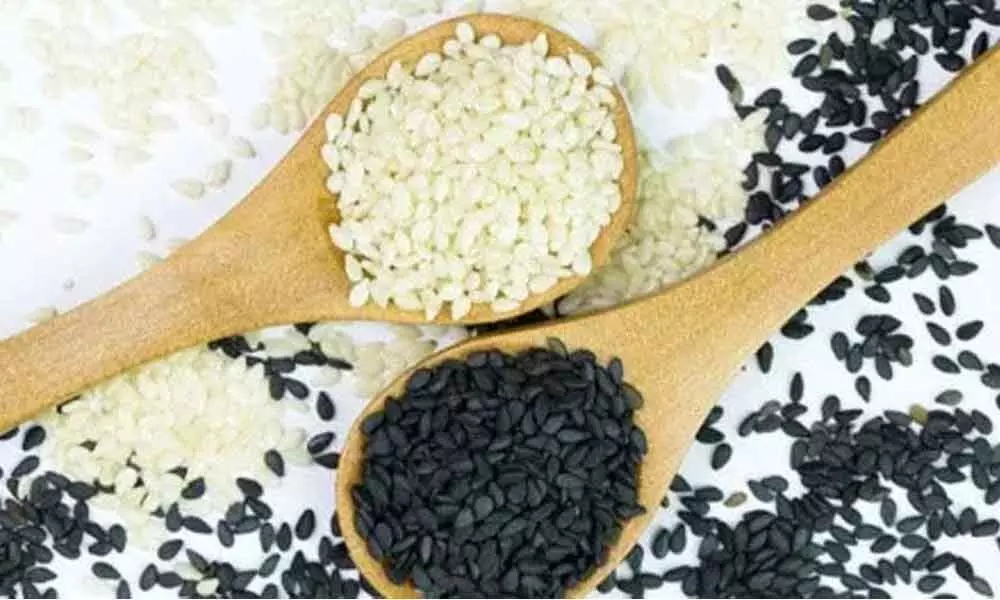Live
- WPL 2025: Matthews, Sciver-Brunt and Harmanpreet carry MI to massive 213/4
- MLA Anirudh Reddy Accuses KTR of Involvement in Manhattan Project Scam
- TGPSC Clarifies on False Propaganda Regarding Group-1 Recruitment
- Hyderabad Police Ensures Security as Holi and Ramadan's Second Friday Coincide
- Five MLCs Elected Unopposed in Telangana Under MLA Quota
- Sambhal prepares for a peaceful Holi with tightened security and special patrols
- CNG, PNG prices to become cheaper in Rajasthan from March 14
- Anti-Rape ad to screen in theaters before movies, like health advisories
- Prodigy Finance Offers Three Scholarship Awards totalling an amount of $19,000 for Global Students Starting Fall 2025
- Champions League drama likely to affect La Liga with big games this weekend
Lohri, Pongal: The Benefits and Significant use of sesame seeds on Makara Sankranti


Makara Sankranti is one of the most auspicious days for the Hindus, and is celebrated almost universally by all Hindus across the country in many forms and Hues, with devotion, fervor, and gaiety.
Makara Sankranti is one of the most auspicious days for the Hindus, and is celebrated almost universally by all Hindus across the country in many forms and Hues, with devotion, fervor, and gaiety.
As per the Hindu calendar, there are 12 Sankranti in a year. Makar Sankranti or Til Sankranti as it is called in many places, it holds a special place among them. This festival is also mentioned with reverence in Bhagwat Gita and Mahabharata.
Makar Sankrant, Sankranti, Lohri, Uttarayana, Pongal are the festivals of cultivation, celebrated across the county. They mark the beginning of harvest season when new crops are worshipped and shared with relish. Sankranti, celebrated in North India has a special significance as it marks the worship of warm winter foods, signifying their importance at a time when the body needs them the most.
Sesame or til which holds special significance during Makar Sankranti is revered as the grain par excellence and is eaten and given away in daan.
Til, gud ghya ni god bola', is a common expression used to greet family and guests in Marathi households during Sankranti celebrations. The expression literally means "Eat til and gur and speak well." Til and gur are two of the most commonly consumed foods in winters. In the winter-y days preceding Sankranti, families prepare delicacies made of til and gur like gajak, chikki and til ka laddoo.
As per Hindu mythology, the god Yama blessed the sesame seed and hence they are regarded as the symbols of immortality. The seed was supposed to have originated when drops of sweat trickled from Vishnu and fell on earth.
But why is this tiny little seed valued so much?
"Sesame is a rich source of vitamins, minerals, healthy oils. It contains calcium, iron, magnesium, phosphorus, manganese, copper, zinc, fiber, thiamin, vitamin B6 and folate. It is also a good source of protein."
Til, Teel or Sesame is one of the oldest oilseeds known to humanity. Not just for its crunch and taste, sesame has been a part of rituals since ancient times. Here are some surprising facts about sesame which shows why it holds so much significance in Indian culture and religion.
Why we celebrate Makarsankranti and its Significance
On JANUARY 12, 2018 in MYTHOLOGY, FESTIVALS, AND GODS
Why we celebrate Makarsankranti and its Significance
"Til-gul ghyaa, aani goad-goad bola"
On Sankranti, u hear every one feeding the til and gud powder to each other and saying this to each other
Accept this til-gul (sweet) and utter sweet words
Sweetening the Life on Makar Sankranti
Today on this day of Makar Sankranti, let us exchange Til (Sesame seeds) and Gul (Jaggery) and release the ill feelings of the past and go towards a sweeter journey.
Makar Sankranti starts an auspicious phase in the Year. It is said to be the 'holy phase of transition'. It marks the end of an inauspicious phase which according to the Hindu Calendar begins around mid-December. From this day any auspicious and sacred ritual can be started.
Scientific Background of Makar Sankranti
Scientifically, this day marks the beginning of warmer and longer days compared to the nights. In other words, Sankranti marks the termination of the winter season and the beginning of a new harvest or spring season. The Sun ends its southward journey or Dakshinayana at the Tropic of Capricorn and starts moving northward or Uttarayana towards the Tropic of Cancer on this day in mid-January. The Sun's movement changes and the days from this day onwards become lengthier and warmer and so the Sun God is worshipped on this day as a great benefactor.
Legends of Makar Sankranti:
It holds a special significance because on this day, Goddess Durga in the form of Mahishasurmardini first set foot on earth, in the Kataraaj Ashram of Rishi Kardam and Devahuti with the purpose of destroying the demon Mahishasur. Mahishasur symbolizes the vices of discontentment, ungratefulness and darkness of ignorance within. So, praying to Durga makes one progress in spiritual journey and brings in the Light from the Sun to illuminate the Citta. The legend states that a successful businessman was curious as to why his supply of sesame seeds seemed to be never-ending. When he inspected the bag he found an idol of Lord Vishnu, the Preserver. According to Mahabharata, Bhishma, who had the power to control his own death, chose to die on the day of Makar Sankranti.
Hence, Makar Sankranti stands as an epitome of new beginning, divine radiance, and all-auspiciousness. Starting a new venture on this day is highly auspicious. It is the day when all of the negative elements in the cosmos are overpowered by the Divine elements (satvik tattvas) therefore one can take advantage of this great festival and invite positivity into their personal as well as professional life.

© 2025 Hyderabad Media House Limited/The Hans India. All rights reserved. Powered by hocalwire.com






